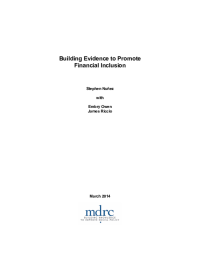Building Evidence to Promote Financial Inclusion
In the last 30 years, practitioners and scholars interested in designing programs and policies that improve the lives of low-income individuals have increasingly focused their attention on issues pertaining to financial inclusion: the expansion of access to mainstream credit, banking, and financial services. This new emphasis is motivated by several interconnected observations concerning the ways in which lack of access to the mainstream financial system, inability to navigate within that system, or inability to effectively manage one’s own finances can worsen the economic security of low-income groups or make it harder for them to become financially self-sufficient.
Interest and investments in such strategies have grown dramatically, and this growth has fed an increasing desire to understand how well these kinds of interventions work. Unfortunately, high-quality evidence in this field is in short supply, although it is slowly accumulating. This paper attempts to offer some guidance by exploring the current state of evidence in the financial inclusion field. Toward that end, the paper focuses attention on a selection of programs, each of which illustrates a certain type of approach within the field of financial inclusion. It concludes with a broad assessment of the state of evidence in this field and suggestions for how to strengthen the evidence base further.
The field of financial inclusion includes a wide variety of initiatives. Some programs offer access to accounts provided by banks and credit unions for both aspirational and emergency savings, and provide further incentives for savings with automatic deposits or matching funds. Other programs include, in various combinations, financial literacy and credit repair, drives to sign up the “unbanked” (people without bank accounts) for no-cost checking and savings accounts, and the development of easy-to-use planning and budgeting products. Microcredit/microfinance organizations offer another potentially important service by providing group or individual access to loans for a variety of uses.
Overall, the evidence on the effectiveness of the various programs promoting financial inclusion is quite limited. Only a relatively small number of interventions have been subjected to rigorous evaluation, and many models or approaches have not been evaluated at all. Given the contexts in which these programs are operating, it can be challenging to design and carry out credible studies. However, some of the work discussed in this paper shows that it is feasible to conduct rigorous experimental and quasi-experimental evaluations in many circumstances, and the field would benefit from more such studies.
This review focuses primarily on understanding the effectiveness, or impacts, of financial inclusion programs and policies. However, a comprehensive evaluation would also include analyses to understand the implementation and operation of the program and a cost-benefit analysis. Efforts to build the scope and quality of evidence of financial inclusion interventions would benefit from stronger analyses of those types as well. Benefit-cost analyses are especially rare in this field.






